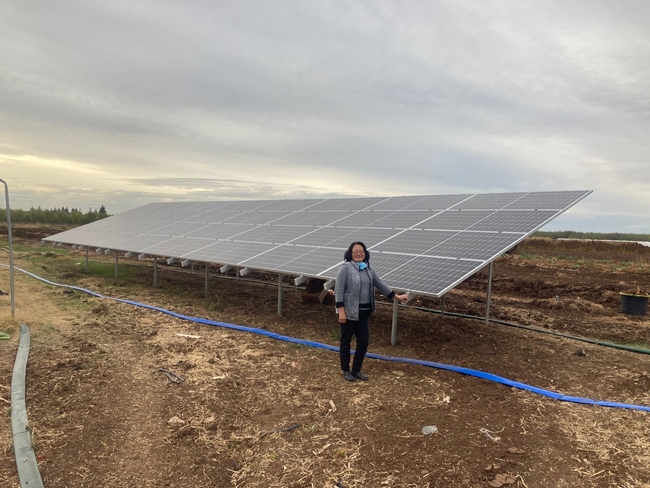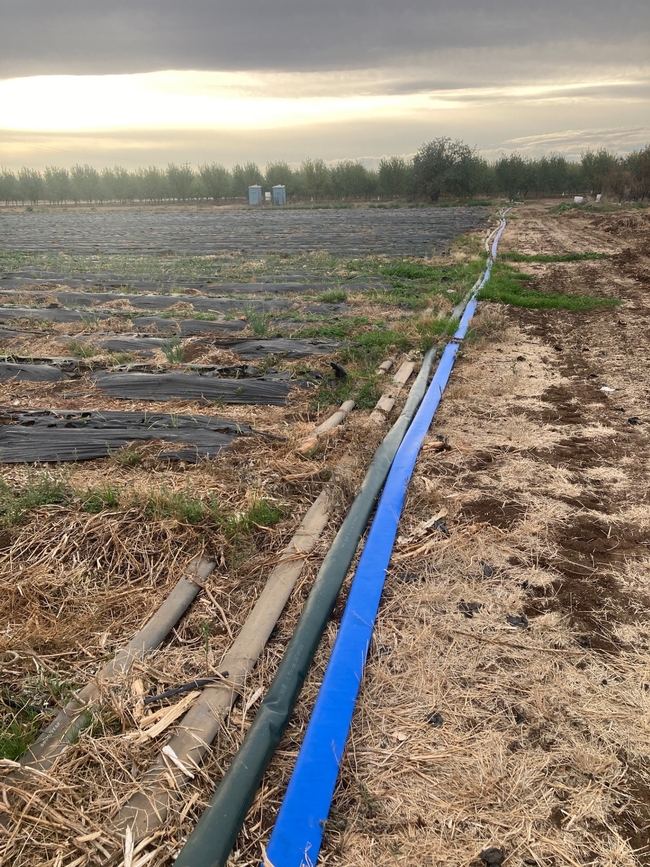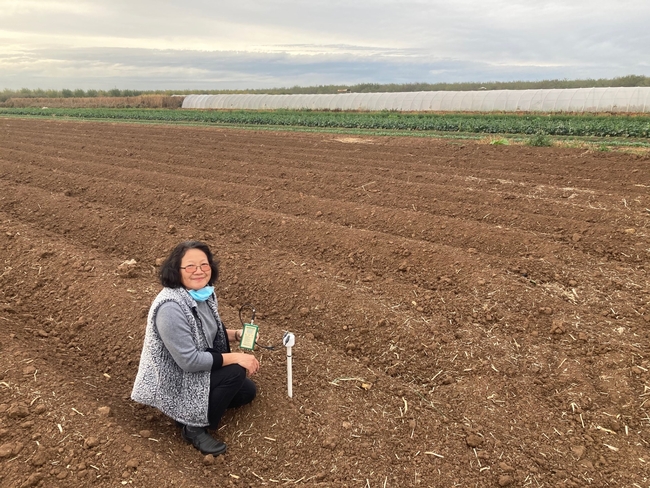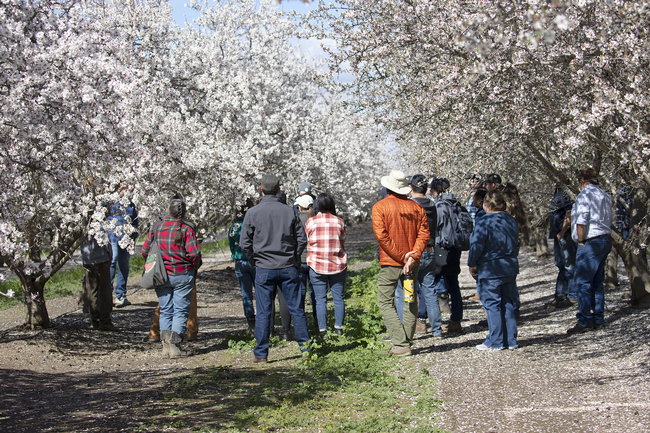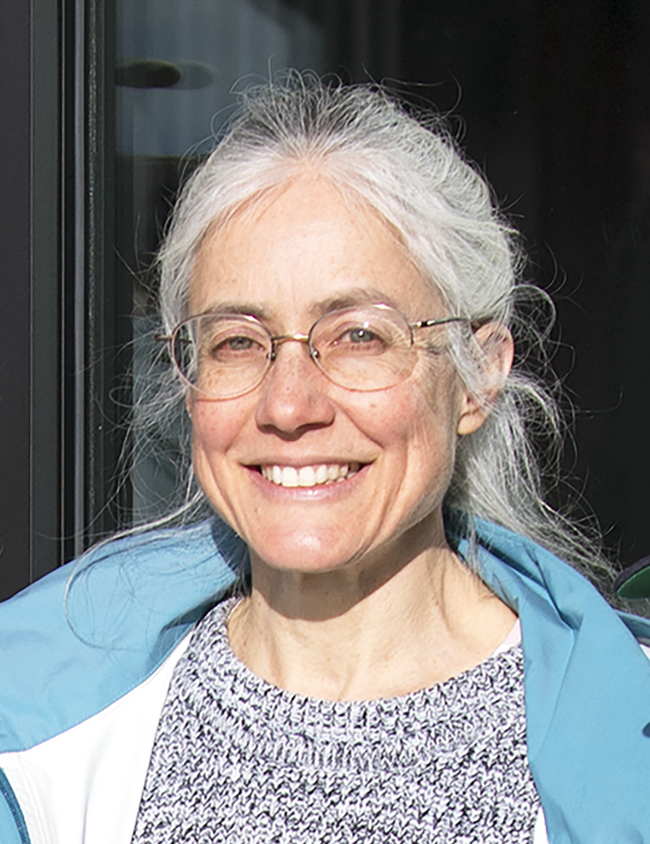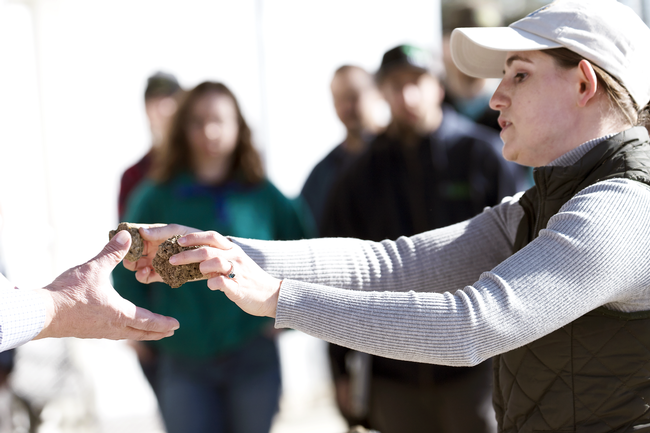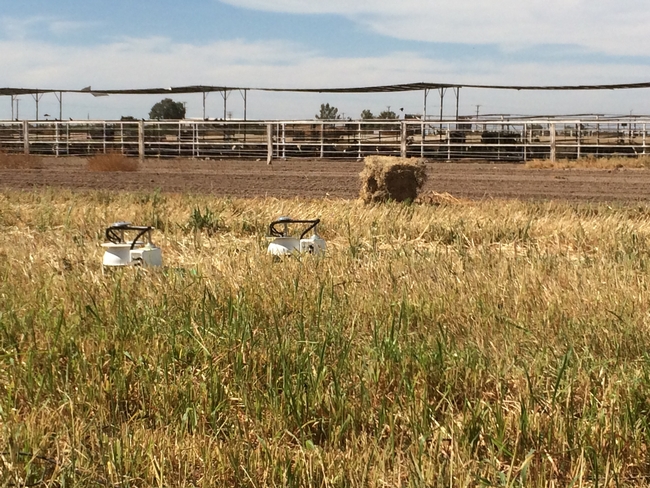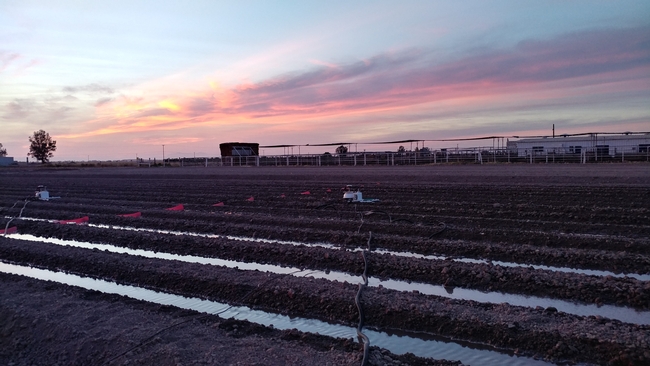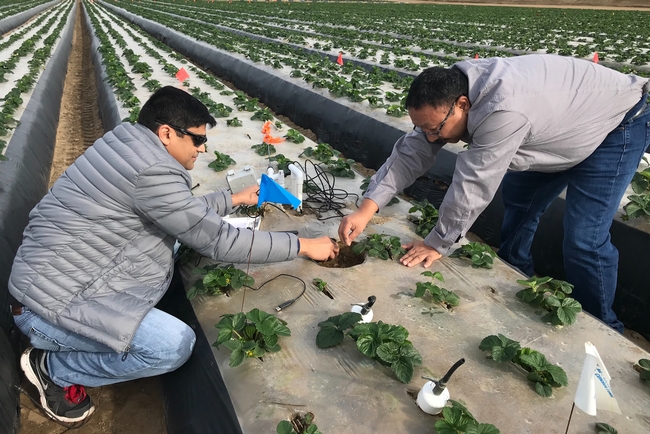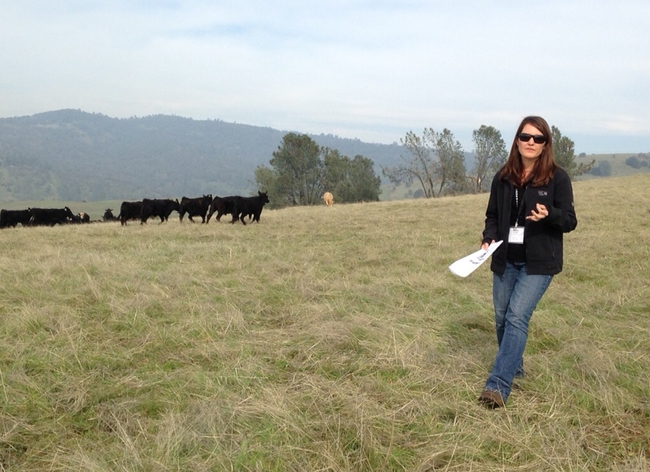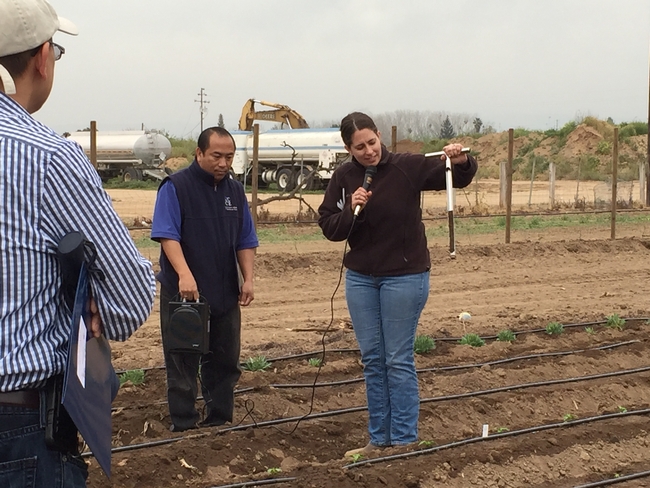Posts Tagged: Climate-smart
Farmers save money, water by adopting climate-smart agriculture practices
CDFA, UC ANR help farmers access $36 million in grants to improve water-use efficiency, reduce greenhouse gas emissions
A Hmong small-scale farmer in Merced County has saved about 14.4 acre-inches of water annually and reduced greenhouse gas emissions by 12.406 MTCO2e per year (equivalent to the greenhouse gas emissions produced from burning 1,396 gallons of gasoline) after upgrading her farm. Rosie Lee – who sells Asian greens, green beans, corn, strawberries and other produce at her farm stand and to Asian markets – is one of hundreds of growers benefiting from California Department of Food and Agriculture incentives and funds with the assistance of Climate Smart Agriculture community education specialists.
“She is one grower who would not have access to those funds without my bringing my computer out to the field,” said Caddie Bergren, a Climate Smart Agriculture community education specialist who has been working with growers in Merced County since theprogram's launch.
To make it easier for farmers to adopt new practices, CDFA and UC Agriculture and Natural Resources partnered to create the Climate Smart Agriculture program.
"Since 2019, UC ANR's Climate Smart Agriculture Team has provided in-depth technical assistance to more than 1,300 farmers and ranchers in 25 counties,” said Hope Zabronsky, academic coordinator for UC ANR's Climate Smart Agriculture team. “Through their strong relationships with diverse farming communities, they support the implementation of soil health, water efficiency and manure management practices that optimize climate benefits for all growers and Californians.”
The program's community educators work with farmers and ranchers in 25 California counties to get CDFA-funded grants and implement Climate Smart Agriculture projects. These efforts, which emphasize outreach to underserved farmers and ranchers, have resulted in a total of $36.5 million invested from the State Water Efficiency and Enhancement Program or SWEEP, the Healthy Soils Program, and the Alternative Manure Management Program.
“Agriculture is an important part of the climate solution,” said CDFA Secretary Karen Ross. “This funding enables CDFA and UC ANR to partner with farmers and ranchers to scale up climate-smart agricultural practices. This is essential as we contend with our hotter, drier future.”
Lee, the Hmong grower, had been growing 18 acres of vegetables by flood irrigating with groundwater. To save water and reduce pumping costs, she asked Bergren to help her apply for SWEEP funds to convert to drip irrigation and install solar panels. Bergren brought her laptop to the field to help Lee pull together the necessary information for the application. After Lee received funds for the project, Bergren assisted her with the technical logistics of installing the irrigation and solar equipment.
“I called vendors and we were able to complete the project on time,” Bergren said.
CDFA and UC ANR have published an impact report highlighting the results of the multi-year partnership focused on increasing adoption of climate-smart agriculture practices to reduce water and energy use.
The investments have funded more than 420 projects, so far. The projects are expected to save an estimated 8.3 billion gallons of water during their lifetime, enough to supply over 75,000 typical homes in California with water for a year. Additionally, there are projected reductions of more than 355,000 metric tons of carbon dioxide-equivalent, as much as would be achieved by removing 79,110 gas-powered vehicles from roads.
The report highlights the importance of providing tailored outreach, education and technical assistance to small-scale, non-English speaking, and otherwise underserved farmers and ranchers.
To find the full details of the report, please visit https://ucanr.edu/climatesmartag2023.
[Updated Sept. 29 to show UC ANR's Climate Smart Agriculture Team has provided technical assistance to farmers and ranchers in 25 counties, not 24 counties.]
UC awards Brodt $2M to advance soil health, climate-smart farming practices
Regional farms will demonstrate practices such as cover cropping, reduced tillage, compost and mulch use, hedgerow planting, optimized irrigation systems
To accelerate adoption of climate-smart farming practices, the University of California Office of the President has awarded nearly $2 million to a team of UC Cooperative Extension scientists and community partners working on a network of farm demonstration sites. The project will be led by Sonja Brodt, coordinator for agriculture and environment at the UC Sustainable Agriculture Research & Education Program. This UC Agriculture and Natural Resources project is one of 38 funded with $83.1 million allocated to UC by the State of California for climate action research and innovation.
Scaling up soil health and other climate-smart agricultural practices to sequester carbon, increase water and nutrient use efficiency, and improve the resilience of farms to climate-related threats like drought and floods is a core pillar identified in California's Natural and Working Lands Climate Smart Strategy.
Climate-smart agriculture is a systems-based approach that requires localized adaptation across the diverse soils, cropping systems, socioeconomic and cultural contexts throughout California.
“Our project will strengthen the nascent California Farm Demonstration Network for on-the-ground, regionally specific demonstration of a range of climate-smart practices,” said Brodt. “Regional farms will demonstrate practices such as cover cropping, reduced tillage, compost and mulch use, hedgerow planting, irrigation system optimization and more.”
The $1,999,524 project will pilot a participatory partnership extension model that allows farmers to learn from their peers to reduce adoption risks and adapt knowledge to an ever-changing environment, increasing the likelihood of farmer success and accelerating long-term uptake of complex, place-specific practices.
Building on the capacity of local trusted organizations, project collaborators will be organized in a hub-and-spoke network with three regional Farm Demonstration Hubs (Sacramento Valley, North Coast and Central Coast), a pilot Hmong/Mien Demonstration Hub, and a statewide Organic Demonstration Hub.
Collaborators at each hub will be responsible for identifying and nurturing farm demonstration sites, and conducting demonstration trials and farmer-to-farmer outreach activities. Centralized organization and capacity building will be provided by UC SAREP, UC Organic Agriculture Institute, the California Association of Resource Conservation Districts, the Community Alliance with Family Farmers, and the California Farm Demonstration Network Advisory Panel.
In addition to several UC Cooperative Extension advisors and specialists across the state, partners include the UC Hansen Research and Extension Center and the Rodale Institute California Organic Center, both in Ventura County, and the UC Climate Smart Agriculture Program. Eight Resource Conservation Districts will also be involved in leading Farm Demonstration Hubs.
The project will also conduct soil health assessment activities to inform soil health and resilience monitoring protocols in future research and extension efforts. Since many existing soil health metrics were designed for agroecosystems in the Midwest and Eastern U.S., this project aims to lay the groundwork for research to adapt soil health metrics to the arid and Mediterranean climates of California.
“By utilizing relationships built between demonstration hub managers and demonstration farms across different cropping systems, we will gather quantitative and qualitative soil health data, information about growers' management practices as well as their own perspectives of what they really need to know about their soils in order to better manage for climate resilience and mitigation,” said Brodt.
Ultimately, the project partners aim to establish an enduring on-farm extension and research system that will help thousands of farmers adopt climate-smart practices tailored to their farms.
Other grant-supported projects focus on water access, conservation
The largest of the Climate Action Matching Grants, an $8.2 million investment, supports the development of planning tools to advance sustainable, inclusive and equitable water distribution for California's 39 million people. The project is led by Ted Grantham, a UC Cooperative Extension specialist in the Department of Environmental Science, Policy and Management at UC Berkeley. Kristin Dobbin, UC Cooperative Extension specialist in the Department of Environmental Science, Policy, and Management at UC Berkeley, and Erik Porse, director of the California Institute for Water Resources are collaborating on the project.
Three other projects involving UC ANR researchers received California Climate Action Seed Grants and Matching Grants subawards:
- Development of a hydrogel that can work as a soil amendment to help small-scale vegetable farms conserve water led by UC San Diego associate professor Shengqiang Cai with Ruth Dahlquist-Willard, UC Cooperative Extension small farms advisor and interim director of UC SAREP; Mallika Nocco, UC Cooperative Extension specialist; and Matthew Gilbert, UC Davis professor of whole plant physiology. $297,979
- Development of a tool for predicting climate-water variation led by UC Irvine professor Isabella Velicogna with Tapan Pathak, UC Cooperative Extension specialist. $199,531
- A study of urban stream corridors led by UC Davis professor Gregory Pasternack with Igor Lacan, UC Cooperative Extension environmental horticulture and urban forestry advisor. $33,824
- A study of how California's housing crisis affects the growth of the wildland urban interface (WUI), where the fringes of development reach into natural areas led by UC Santa Cruz professor Miriam Greenberg, with Barb Satink Wolfson, UCCE fire advisor, Devii Rao, UCCE livestock and natural resources advisor, and the Central Coast Prescribed Burn Association.
Updated 8/31/23 to add the wildland urban interface study.
Drip irrigation in arid regions can cut greenhouse gas emissions, improve air quality
Study at Desert Research and Extension Center highlights agriculture's sustainability role
Under the blistering sun of Southern California's Imperial Valley, it's not surprising that subsurface drip irrigation is more effective and efficient than furrow (or flood) irrigation, a practice in which up to 50% of water is lost to evaporation.
But a recent study also concludes that drip irrigation can dramatically reduce greenhouse gas emissions from soil – which contribute to climate change and unhealthy air quality in the region – without sacrificing yields of forage crops alfalfa and sudangrass.
“It was really exciting to see,” said lead author Holly Andrews, a National Science Foundation postdoctoral fellow at the University of Arizona. “The crop yield was at least maintained and in some cases increased, but the water use and gaseous emissions were especially decreased under drip irrigation.”
Desert REC crucial to collecting data
Andrews and her colleagues gathered data from field studies at University of California Agriculture and Natural Resources' Desert Research and Extension Center, a crucial hub of desert agriculture research for more than 100 years. Studies in that context are increasingly important, as much of California and the Southwest becomes hotter and drier.
“We already have this history of looking at drip irrigation at this site, so our study was trying to build on that,” said Andrews, who lauded Desert REC's facilities and staff.
In their study published in Agriculture, Ecosystems & Environment, researchers found that – in comparison to furrow irrigation – drip irrigation in alfalfa slashed per-yield soil carbon dioxide emissions by 59%, nitrous oxide by 38% and nitric oxide by 20%.
Nitrous oxide is a greenhouse gas with nearly 300 times more warming potential as carbon dioxide, and nitric oxide is a precursor to ozone and major contributor to air pollution.
While drip irrigation only decreased water demand 1% in alfalfa, the practice led to a substantial 49% decrease in irrigation for sudangrass. For more fertilizer-intensive sudangrass, drip irrigation also reduced soil emissions of nitrous oxide by 59% and nitric oxide by 49% – the result of drip irrigation making those fertilizers more efficient.
Water management can help mitigate climate change
Studying alfalfa and sudangrass – forage crops with very different fertilizer requirements – was a strategic choice by the researchers. They are number one and number three on the list of most widely grown crops by acreage in the Imperial Valley (Bermudagrass, another forage crop, is number two).
With so much land dedicated to producing these crops, the adoption of drip irrigation at scale could deliver significant benefits to residents' health and quality of life.
“The thought that saving water can increase yields while lowering the emission of trace gases that affect regional air quality and Earth's climate is quite encouraging,” said Pete Homyak, an assistant professor of environmental sciences at UC Riverside who contributed to the study. “This is especially true for the Imperial Valley, an arid region where water is a limited resource and where residents are exposed to bad air quality.”
Homyak, who is affiliated with UC ANR through UC Riverside's Agricultural Experiment Station, said that this study illustrates how changes in water management can substantially mitigate agricultural impacts on the environment.
The study findings should encourage growers to replace furrow irrigation systems with drip irrigation infrastructure – especially in combination with financial incentives from the state, such as cap-and-trade and carbon credit programs, that can help defray high installation costs.
“It really is worthwhile if you're thinking sustainability and environmental activism in how agriculture can actually support climate change mitigation,” Andrews explained. “These practices might be a way that we can start to change that picture a little bit – and make agriculture more sustainable by tailoring irrigation management to local climate conditions.”
In addition to Andrews and Homyak, the other study authors are Patty Oikawa, California State University, East Bay; Jun Wang, University of Iowa; and Darrel Jenerette, UC Riverside.
UC Davis to lead $15 million research into climate-change resistant wheat
The project will also train plant breeders for the future
Wheat products account for roughly 20% of what people eat every day around the globe. As climate changes, wheat crops must adapt to new weather patterns to keep up with demand.
The University of California, Davis, is leading a five-year, $15 million research project to accelerate wheat breeding to meet those new climate realities, as well as to train a new generation of plant breeders.
“Everything is less stable,” said Jorge Dubcovsky, a plant sciences distinguished professor who is leading the grant research. “Everything is changing so you need to be fast. You need to be able to adapt fast.”
The grant from the U.S. Department of Agriculture's National Institute of Food and Agriculture will create a coordinated consortium of 41 wheat breeders and researchers from 22 institutions in 20 states. Researchers from Mexico and the United Kingdom are also participating.
Breeding needs to speed up
“Breeding crops for the future will require new traits, breeding platforms built for quick transfer of traits to elite cultivars, coordination of breeding efforts in public and private domains, and training for current and future plant breeders and researchers,” NIFA said in an announcement about this grant and others related to breeding.
The program involves on-the-ground research, identifying molecular markers and data analysis from multiple institutions to determine genes that will help wheat crops mitigate the effects of climate change. Plant breeding will follow to prove out those findings.
Wheat is unlike other crops in that 60% of the plant varieties — generating about $4 billion in annual production — are developed by public breeding programs rather than private corporations. In many states, wheat growers tax themselves to support basic breeding efforts at public institutions like UC Davis.
Increased coordinated research
The NIFA grant money will lead to more coordinated, sophisticated research. “This grant allows us to do breeding at a level that a good, modern company would do,” Dubcovsky said. “This grant is essential to maintain modern and effective public breeding programs in the U.S.”
The consortium will bring together data and research from across institutions, allowing for more expansive analysis while reducing redundancies. “We can take advantage of the data from everybody,” he said. “By doing that we don't need to duplicate efforts.”
A team in Texas will analyze plant images taken from drones at each institution to extract information about plant growth, water use, nitrogen levels and other data. “Using technology, we can see beyond our human capabilities,” Dubcovsky said. “You can extract a huge amount of information from every plant variety.”
The data from those images will allow researchers to document the plants throughout the life cycle and determine which plants fare better under certain conditions. Genotyping will help researchers obtain information about the plant genome. The combination of these two types of data could speed up breeding cycles, helping wheat crops adapt to a changing environment.
“If we can breed fast, we can adapt to change,” Dubcovsky said. “We are trying to make sustainable improvements in time.”
Training the next generation
The project will also train a cohort of 20 plant Ph.D. students in active breeding programs where they will participate in fieldwork, collect data from drones and DNA samples, and learn to integrate that information to accelerate wheat breeding. The students will participate in online and face-to-face workshops, as well as educational events and national scientific conferences.
Colorado State University, Cornell University, Kansas State University, Michigan State University, Montana State University, Oklahoma State University, Purdue University, South Dakota State University, Texas A&M University, University of Idaho, University of Illinois, University of Minnesota, University of Nebraska, University of Wisconsin, Utah State University, Virginia Tech, Washington State University, and U.S. Department of Agriculture Agricultural Research Service branches in North Dakota, Washington, Kansas and North Carolina are also participating in the consortium.
UC ANR scientists receive $1.5M NIFA grant for climate-smart agriculture
To help California farmers and ranchers adjust to uncertain weather and climate events, the USDA National Institute for Food and Agriculture has awarded $1.5 million to a team of scientists led by UC Agriculture and Natural Resources. The project is one of six projects funded by USDA NIFA's $9 million investment to expand adoption of climate-smart practices.
“The Cooperative Extension system and the USDA Climate Hubs have unmatched capacity to reach agricultural, Tribal and underserved communities, as well as educators and students, and our nation's farmers directly,” said Agriculture Secretary Tom Vilsack in a statement announcing the grant recipients. “This partnership will strengthen climate research efforts and accelerate the development, adoption and application of science-based, climate-smart practices that benefit everyone.”
California has the largest and the most diverse agricultural economy in the nation, with revenue exceeding $50 billion, which is larger than the revenues of the other 10 Western states combined. Despite its size, the state is highly vulnerable to climate change.
“California farmers and ranchers need locally relevant climate information and adaptation resources,” said Tapan Pathak, UC Cooperative Extension specialist based at UC Merced and principal investigator for the grant. “Similarly, technical service providers are often ill-equipped to assist farmers and ranchers when asked questions about climate change, weather variability and local implications to implement those decisions.”
To train the next generation of workers to be climate-ready, colleges expose students to climate science and agricultural science separately, but often lack opportunities for the students to learn about the nexus of climate and agriculture.
Pathak plans to provide classes – along with opportunities for practical learning experiences – to farmers, ranchers, agricultural service providers and students.
“An overarching goal of this project is to develop robust multifaceted pathways to climate-smart agriculture by integrating Extension and participatory education program development and delivery to enhance agricultural resilience to climate change,” he said.
“To tackle this ambitious goal, we have a large team of multidisciplinary leading scientists and experts from local, state and federal agencies, the California Climate Hub and the University of California ready to work with diverse stakeholder groups.”
UC Cooperative Extension specialists Leslie Roche, Vikram Koundinya and Daniele Zaccaria at UC Davis; Mark Cooper, UC Davis professor; and Steven Ostoja of the USDA California Climate Hub, are co-principal investigators with Pathak.
They will begin with a needs assessment for all of their stakeholders, including socially disadvantaged farmers and ranchers. Through three components, the project team will work to understand growers' perception of climate change-related threats, build capacity for technical assistance providers to advance climate-smart agriculture research and delivery of science-based information, and educate community college and undergraduate university students.
Engaging with farmers and ranchers
With the help of community partners including the Community Alliance of Family Farmers and the California Association of Resource Conservation Districts, the team will reach out to socially disadvantaged and limited-resource producers, including beginning and first-generation farmers and ranchers to attend regional workshops, led by instructors who are fluent in Spanish and Hmong.
Workshop content will address a broad range of topics including climate change trends and local impacts, drought planning strategies, optimization of agricultural productivity with limited resources and farm and ranch economic sustainability.
“California has so much diversity in terms of scale, crops, geography, micro-climates, market conditions and natural resource considerations that a one-size-fits-all approach will not work,” wrote Renata Brillinger, CalCAN executive director, in her letter supporting the project. “We support your plans to address the needs of producers though region-specific workshops.”
Five county-based UC Cooperative Extension academics will serve as regional leads for the farming workshops across broad geographic regions:
- Andre Biscaro, UCCE irrigation and water resources advisor serving Ventura County
- Ruth Dahlquist-Willard, UCCE small farms advisor for Fresno and Tulare counties
- Surendra Dara, UCCE entomology and biologicals advisor serving San Luis Obispo and Ventura counties
- Jairo Diaz, director of the UC Desert Research and Extension Center in Southern California
- Jhalendra Rijal, UCCE integrated pest management advisor serving San Joaquin and Merced counties
Workshops for ranchers and rangeland managers will be coordinated by UCCE rangeland and livestock advisors in their respective regions:
- Dan Macon, UCCE livestock and natural resources advisor for Plumas, Nevada, Sutter and Yuba counties, will organize workshops for the Sierra Nevada mountains and foothill region
- Grace Woodmansee, UCCE livestock and natural resources advisor for Siskiyou County, will organize workshops in Northern California
- Rebecca Ozeran, UCCE livestock and natural resources advisor for Fresno and Madera counties, will organize workshops in Central California
- Devii Rao, UCCE livestock and natural resources advisor for Monterey, San Benito and Santa Cruz counties, will organize workshops in the coastal region
- Brooke Latack, UCCE livestock advisor for Imperial, Riverside and San Bernardino counties, will organize workshops in Southern California
Training technical service providers
The team will offer climate-smart agriculture trainings for technical service providers on how to prepare for key stressors in California agriculture such as floods, droughts, wildfires and heatwaves; effective climate communications; invasive pests and disease management under future climate; and weather and climate resources and decision support tools for managing risks.
One of the aims of this component is to encourage more coordinated efforts among different agencies to deliver climate change resources to their respective stakeholders, Pathak said.
California Cattlemen's Association has expressed its support for the project.
“Given ranchers' strong relationships with and reliance upon technical services providers – particularly those housed within the USDA and University of California – CCA also sees great value in the project's goal of building capacity within those organizations to assist ranchers in addressing the challenges of climate change,” wrote Kirk Wilbur, CCA vice president of government affairs.
Nurturing future generations
For college students, there will be the UC Merced Summer Institute on Climate and Agriculture certificate course organized by Karina Diaz Rios, UC Cooperative Extension specialist based at UC Merced; the UC Davis credit-based course “Science and Society: Climate Change and Agriculture;”and a certificate course for community college students, which will be overseen by the Bay Area Community College Consortium of 28 colleges.
“We will join you in this exciting work and shared vision towards inclusive education in climate resilient agriculture,” wrote Nancy Gutierrez, statewide director of the Agriculture, Water, Environmental Tech sector of the California Community College System.
Students from the three courses will be selected for paid summer internships to engage in Cooperative Extension projects.
“Through climate-smart agriculture education, the workforce will be prepared to advance climate science and research efforts for future generations,” Pathak said.

